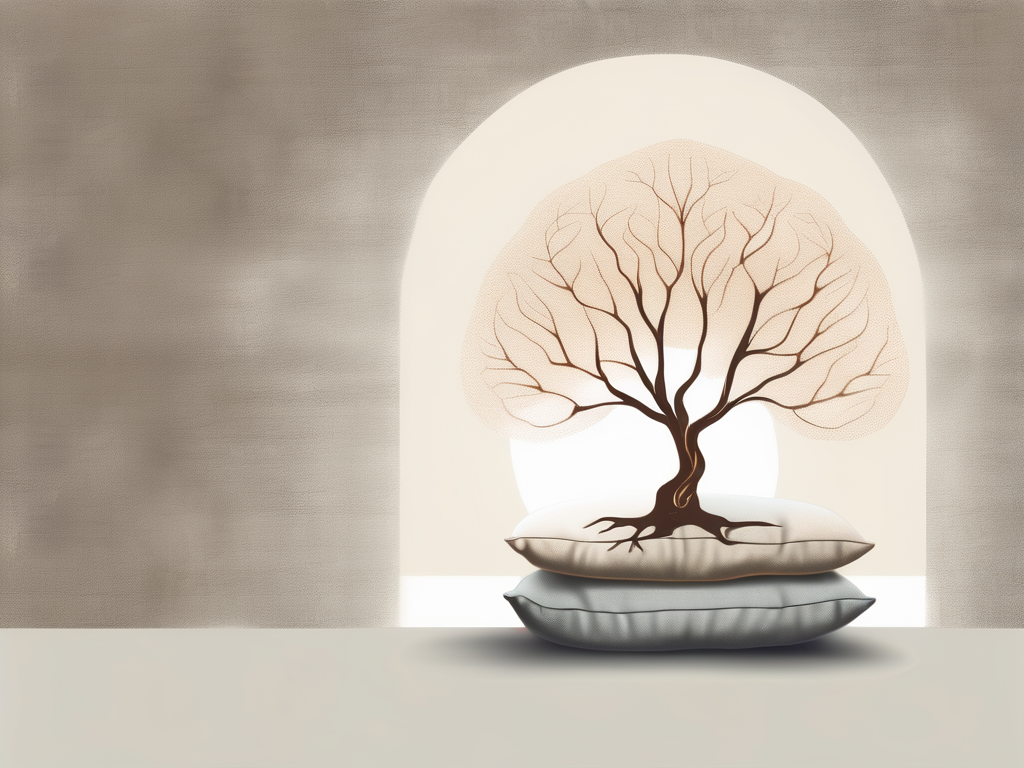The Four Noble Truths form the foundation of Buddhist philosophy and provide a profound understanding of life and suffering. In this article, we will explore the concept of the Four Noble Truths, their origin and significance, their role in Buddhism, and their relevance to modern life. We will also debunk some misconceptions surrounding the Four Noble Truths and examine how they are interpreted in different Buddhist traditions.
Understanding the Concept of the Four Noble Truths
The Four Noble Truths are a central teaching in Buddhism, attributed to Siddhartha Gautama, the historical Buddha. These truths are not mere beliefs or dogmas but rather a contemplative framework that encourages individuals to deeply investigate their experiences and to gain insight into the nature of reality.
When we delve into the concept of the Four Noble Truths, we uncover a profound understanding of the human condition and the path to liberation. It is through the exploration of these truths that individuals can find solace and guidance in their journey towards enlightenment.
The Origin and Significance of the Four Noble Truths
The Four Noble Truths were first expounded by the Buddha during his first sermon, known as the Dhammacakkappavattana Sutta, delivered shortly after attaining enlightenment under the Bodhi tree. This sermon marked the beginning of his teaching mission and laid out the essential teachings of Buddhism. The Four Noble Truths encapsulate the essence of the Buddha’s enlightenment and provide a roadmap for overcoming suffering and attaining liberation.
As we reflect upon the origin of the Four Noble Truths, we are transported to the serene setting of the Bodhi tree, where the Buddha experienced his profound realization. It was here, in the depths of his meditation, that he comprehended the fundamental truths that underpin human suffering and the path to liberation.
The Role of the Four Noble Truths in Buddhism
The Four Noble Truths serve as the foundation upon which the entire Buddhist path is built. They are the diagnosis, the cause, the prognosis, and the prescription for suffering. By understanding these truths, individuals can gain insight into the nature of suffering, its causes, the possibility of its cessation, and the path leading to its end. The Four Noble Truths are considered the first step towards awakening.
When we delve deeper into the role of the Four Noble Truths in Buddhism, we uncover a comprehensive framework that guides practitioners in their pursuit of enlightenment. These truths act as a compass, directing individuals towards a deeper understanding of the human condition and the path to liberation. Through contemplation and practice, one can unravel the intricate web of suffering and find liberation from its grasp.
It is important to note that the Four Noble Truths are not meant to be taken at face value but rather to be deeply contemplated and experienced. They provide a roadmap for individuals to navigate the complexities of existence and find freedom from suffering. By embracing these truths, practitioners can embark on a transformative journey towards awakening and ultimate liberation.
An In-Depth Look at Each of the Four Noble Truths
The Four Noble Truths form the foundation of Buddhist philosophy and provide a profound understanding of the nature of human existence. Each truth offers valuable insights into the causes of suffering and the path to liberation. Let’s explore each truth in more detail:
The Truth of Suffering: Dukkha
The first Noble Truth asserts that suffering (dukkha) is an inherent part of human existence. It goes beyond physical pain and includes the unsatisfactory nature of all conditioned phenomena. This encompasses the fleeting nature of pleasure, the anxiety of impermanence, and the dissatisfaction that arises from unfulfilled desires. By acknowledging and accepting this truth, individuals can confront suffering with wisdom and compassion.
Suffering can manifest in various forms, such as physical illness, emotional distress, or the existential angst that arises from the human condition. It is a reminder that life is not always smooth and that challenges are an integral part of our journey.
The Truth of the Cause of Suffering: Samudāya
According to the second Noble Truth, the cause of suffering is craving (tanha) and attachment to worldly desires. This attachment arises from ignorance (avijja) of the true nature of reality. Our unquenchable thirst for pleasure, material possessions, and recognition keeps us trapped in a cycle of dissatisfaction and suffering.
Craving and attachment create a sense of lack and perpetuate the illusion that fulfillment can be found in external circumstances. This constant pursuit of temporary gratification only leads to further suffering. By recognizing and understanding the causes of suffering, we can begin to loosen the grip of craving and cultivate a sense of contentment and inner peace.
The Truth of the End of Suffering: Nirodha
The third Noble Truth offers hope by proclaiming that there is an end to suffering, known as nirvana. Nirvana is not merely the absence of suffering but a state of profound liberation, peace, and understanding. It is the ultimate goal of Buddhist practice and can be attained by extinguishing the root causes of suffering, namely craving, ignorance, and attachment.
Nirvana is a state of transcendence, where the limitations of the ego dissolve, and one experiences the interconnectedness of all beings. It is a state of profound clarity and liberation from the cycle of birth and death. While nirvana may seem elusive, it serves as a guiding light, inspiring individuals to embark on the path of self-discovery and transformation.
The Truth of the Path to the End of Suffering: Magga
The fourth Noble Truth outlines the Noble Eightfold Path, the practical way to realize the end of suffering. This path consists of eight interconnected factors: right view, right intention, right speech, right action, right livelihood, right effort, right mindfulness, and right concentration.
Practicing these factors cultivates ethical behavior, mental discipline, and wisdom, leading to the cessation of suffering and the realization of nirvana. The Noble Eightfold Path provides a comprehensive framework for individuals to navigate their lives with integrity, mindfulness, and compassion.
By aligning one’s thoughts, words, and actions with the principles of the Noble Eightfold Path, individuals can cultivate a deep sense of inner harmony and contribute to the well-being of others and the world around them.
As we delve into the intricacies of the Four Noble Truths, it becomes apparent that they offer not only a profound understanding of suffering but also a roadmap to liberation. By embracing these truths and incorporating their teachings into our lives, we can embark on a transformative journey towards inner peace and genuine happiness.
The Four Noble Truths and Modern Life
The Four Noble Truths offer valuable insights into the human condition and can be applied to everyday life. By acknowledging the reality of suffering and its causes, individuals can cultivate mindfulness, compassion, and wise decision-making. Through the practice of the Noble Eightfold Path, we can transform our daily experiences and alleviate suffering in ourselves and others.
When we examine the first noble truth, we come to understand that suffering is an inherent part of life. It is not something to be avoided or denied, but rather something to be acknowledged and understood. This understanding allows us to approach our difficulties with greater acceptance and resilience.
Furthermore, by recognizing the causes of suffering, we can begin to address them directly. The second noble truth teaches us that craving and attachment are at the root of our suffering. In our modern society, we are often bombarded with messages that encourage us to constantly seek pleasure and avoid discomfort. However, this constant pursuit of pleasure can lead to dissatisfaction and a lack of fulfillment. By cultivating mindfulness and becoming aware of our desires and attachments, we can begin to break free from this cycle and find greater contentment.
The third noble truth offers hope by reminding us that there is a way out of suffering. Through the practice of the Noble Eightfold Path, we can develop the qualities of wisdom, ethical conduct, and mental discipline. This path provides a roadmap for living a meaningful and purposeful life, free from the grip of suffering.
Lastly, the fourth noble truth emphasizes the importance of putting these teachings into practice. It is not enough to simply understand the Four Noble Truths intellectually; we must actively apply them to our everyday lives. By incorporating mindfulness, compassion, and wise decision-making into our actions and interactions, we can create a positive ripple effect that extends beyond ourselves.
The Four Noble Truths and Mental Health
Many contemporary psychologists and therapists are incorporating Buddhist teachings, including the Four Noble Truths, into their approaches to mental health. By understanding the nature of suffering and its underlying causes, individuals can cultivate greater resilience, emotional well-being, and self-awareness. The teachings of the Four Noble Truths complement various therapeutic modalities and provide a holistic framework for healing and personal growth.
In the field of mental health, the first noble truth can serve as a powerful reminder that suffering is a universal experience. This understanding can help individuals feel less alone in their struggles and foster a sense of empathy and connection with others.
Moreover, the second noble truth sheds light on the role of attachment and craving in mental health issues. Many psychological disorders, such as addiction and anxiety, can be traced back to a strong attachment to certain outcomes or a constant craving for external validation. By recognizing these patterns and cultivating mindfulness, individuals can begin to break free from the grip of these destructive habits and find greater inner peace.
The third noble truth offers hope for individuals struggling with mental health issues. It reminds us that healing and transformation are possible. By following the Noble Eightfold Path and engaging in practices such as meditation, individuals can develop the necessary tools to navigate their mental health challenges with greater ease and resilience.
Lastly, the fourth noble truth emphasizes the importance of integrating these teachings into our daily lives. In the context of mental health, this means actively applying mindfulness, compassion, and wise decision-making to our thoughts, emotions, and behaviors. By doing so, we can cultivate a greater sense of well-being and create a positive impact on our mental health and the well-being of those around us.
Debunking Misconceptions about the Four Noble Truths
Common Misunderstandings about the Four Noble Truths
Unfortunately, there are some common misconceptions about the Four Noble Truths that can hinder a deeper understanding of their profound wisdom. One such misconception is the notion that Buddhism is pessimistic because it acknowledges the existence of suffering. In truth, the Four Noble Truths offer a realistic assessment of the human condition while providing a practical path to alleviate suffering and attain genuine happiness.
The Four Noble Truths: Not a Pessimistic View of Life
Rather than focusing on the negative aspects of existence, the Four Noble Truths invite us to confront suffering head-on with wisdom and compassion. By embracing the truth of suffering and investigating its causes, we can cultivate genuine happiness, peace, and liberation. The Four Noble Truths provide a positive and empowering perspective on life, offering a path to transform our suffering into profound insights and genuine well-being.
The Four Noble Truths in Different Buddhist Traditions
Theravada Buddhism and the Four Noble Truths
In Theravada Buddhism, the Four Noble Truths play a central role. Theravada practitioners emphasize personal insight and the cultivation of mindfulness through practices such as meditation and ethical living. The Four Noble Truths serve as the foundation for the practices leading to enlightenment and are continuously contemplated and realized within the Theravada tradition.
Mahayana Buddhism and the Four Noble Truths
In Mahayana Buddhism, the Four Noble Truths hold significant importance but are often interpreted within the context of the Bodhisattva path, where liberation is not pursued solely for oneself but for the benefit of all sentient beings. Mahayana teachings emphasize compassion, altruism, and the interdependence of all phenomena. The Four Noble Truths are seen as interconnected with ultimate truth, emptiness, and the realization of Buddhahood.
In conclusion, the Four Noble Truths provide a comprehensive framework for understanding suffering and its cessation. They offer a practical path to alleviate suffering and attain profound liberation. Understanding and applying the teachings of the Four Noble Truths can enrich our lives, promote mental well-being, and cultivate compassion and wisdom. Whether we approach them from a philosophical, psychological, or spiritual perspective, the Four Noble Truths hold timeless wisdom that is applicable to the human condition in all its complexity.












